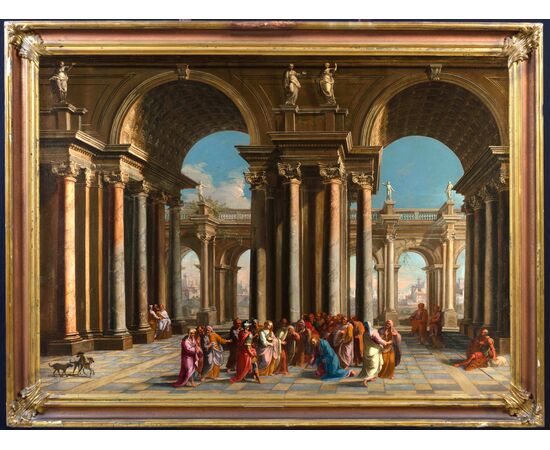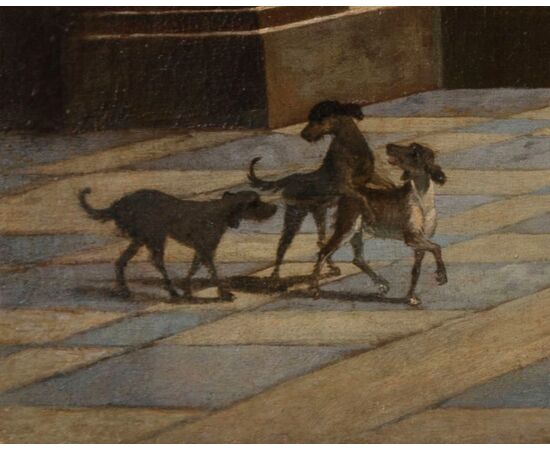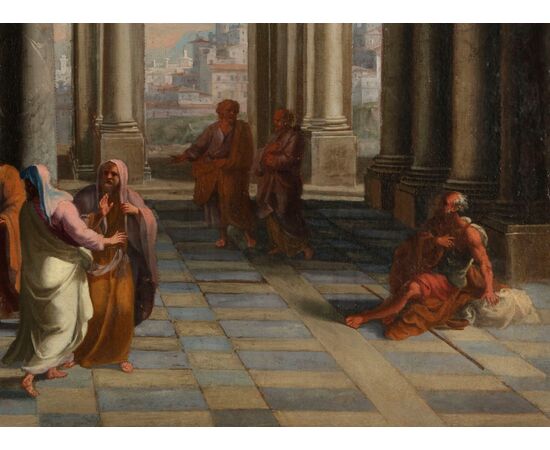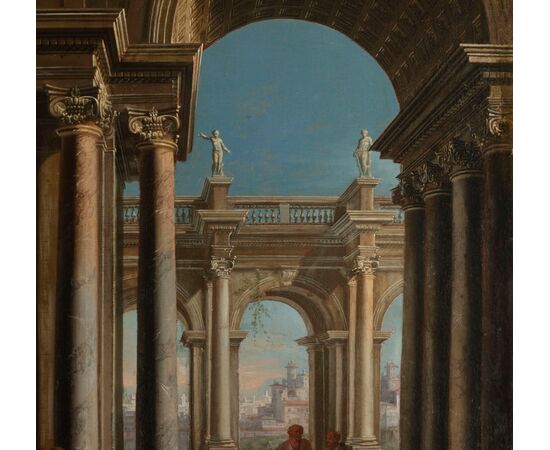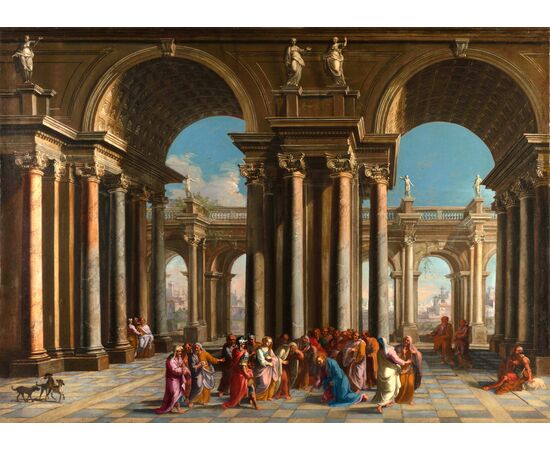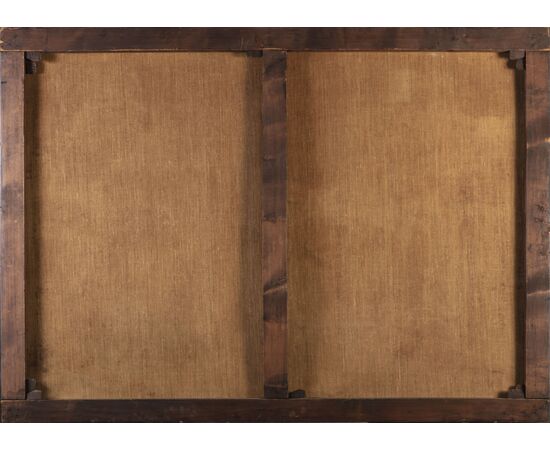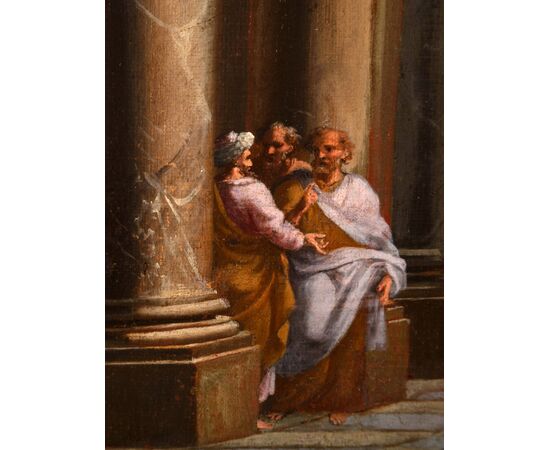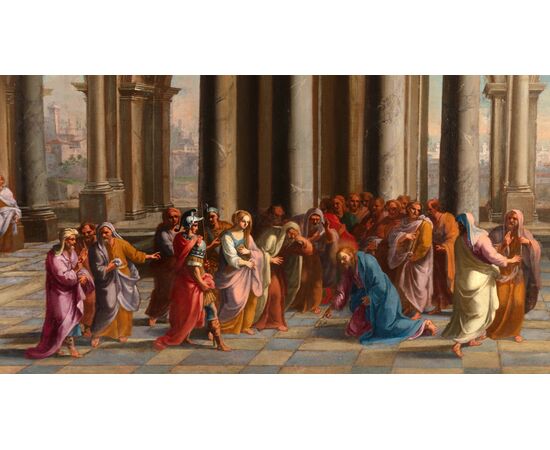Alberto Carlieri (Rome 1672-1720), Christ and the Adulteress, oil on canvas painting
Alberto Carlieri (Rome 1672-1720), Christ and the Adulteress
Oil on canvas, with frame cm H 115 x W 151 x 6.5 - canvas only H 98.5 x W 135 cm
Price: private negotiation
Item accompanied by a certificate of authenticity and historical-artistic expertise (attached at the bottom of the page)
The large and valuable painting, executed in oil on canvas, depicts an architectural capriccio with a massive arched building in the foreground, of which two arches are visible. Large columns and pilasters in the composite Ionic and Corinthian style elongate and lighten the architecture, characterized by a string course cornice on which some marble sculptures rest. In the background, a structurally more graceful colonnade is visible, with a balustrade and sculptures, adorned with greenery sprouting from their top, which gives picturesque characteristics to the canvas. Beyond the arches of the colonnade, a large seventeenth-century city with turreted houses is depicted in the distance. The landscape fades into the horizon towards a blue sky marked by vaporous clouds.
The scenic architecture is animated, in the foreground, by some figures. It is a scene from the Bible: the Pericope of the Adulteress (popularly called the episode of Jesus and the Adulteress), a passage from the Gospel of John (8:1-11) in which a woman caught in adultery is brought before Jesus by scribes and Pharisees to know his opinion regarding her condemnation to stoning. Jesus stooped down and began to write on the ground with his finger. And since the Pharisees insisted, he raised his head and replied, "Let anyone among you who is without sin be the first to throw a stone at her." Then he stooped down again and continued to write on the ground. When they heard these words, they all left except the woman who remained waiting; then Jesus, rising, asked her, "Woman, where are they? Has no one condemned you?" She replied, "No one, Lord." Jesus said to her, "Neither do I condemn you; go, and do not sin again."
The architectural capriccio, an artistic genre that made its way into Italian painting starting from the 17th century, is characterized by the depiction of fantastic architecture or perspective inventions, sometimes combined with elements freely taken from reality. The large canvas in question is of considerable artistic interest. The architecture of invention bestows a solemn classicism on the place; it creates plays of light and shadow and acts as a frame to the scene. The work, painted with great finesse even in the details and small figures, is certainly attributable to the famous Roman painter Alberto Carlieri (Rome, 1672 - 1720), the most appreciated and requested artist in Rome between the death of Giovanni Ghisolfi (Milan 1623-1683) and the affirmation of Giovanni Paolo Panini (Piacenza 1691 – Rome 1765). In the work object of this study, common stylistic motifs of his works can be found. Characteristic elements are the suggestive compositional arrangements and the remarkable mastery in the direction of the lights, as well as the richness of the architecture and the refined as well as the meticulous descriptivism of the details. Peculiar to the author is also the lively attitude of the figures, resolved with ease in the use of color, and harmoniously inserted into the architecture.
Carlieri was born in Rome in 1672 and began studying architecture painting under the guidance of Giuseppe de Marchis. He became a student and then a collaborator of Andrea Pozzo. Present in the most illustrious Roman collections, from the collection of Filippo II Colonna, the Rospigliosi and Cardinal Valenti Gonzaga, Carlieri elaborates well-recognizable compositional models, influenced not only by the painting of the master but also by that of Viviano and Nicolò Codazzi. His pictorial activity can be followed through signed works, around which it has been possible to build a not small catalog of canvases. The news on Carlieri and his signed or dated works are staggered between about 1690 and 1720. Nothing precise is known about the life of the painter, who should have died in Rome shortly after 1720. Among the typical characteristics of Carlieri's style we point out the way in which the perspective develops in the distance: with light colors, cold tones and pastel shades. The late works of the artist present decidedly light tones and in this way differ from the darker tones used by him previously. The author repeatedly depicts the subject described here. Furthermore, in the canvas there are architectural and figurative elements that Carlieri often introduces into his works. The very setting of the majestic architecture is restored in several of his works. The same can be said for the paving, played on the checkerboard effect of a marble pavement which, through perspective, contributes to giving great three-dimensionality and scenic effect to the overall composition. Some figures that Carlieri likes to introduce into the compositions should also be highlighted. Among these there are certainly the dogs that play and frolic lively, as well as the figure of a seated man, with one leg bent and the other semi-stretched which is supported with an arm on the ground. This detail, very frequent and depicted also in a specular way, can almost be considered a signature of Carlieri. Even the couple of men, generally bald and gray-haired and with long beards, who walk and sometimes indicate, are recurring in the canvases of this painter.
Carlotta Venegoni

